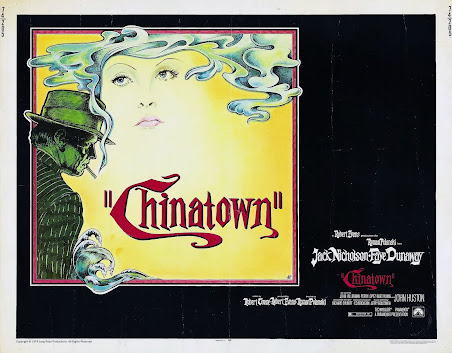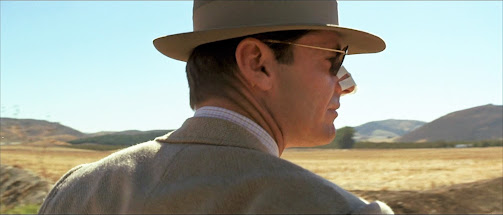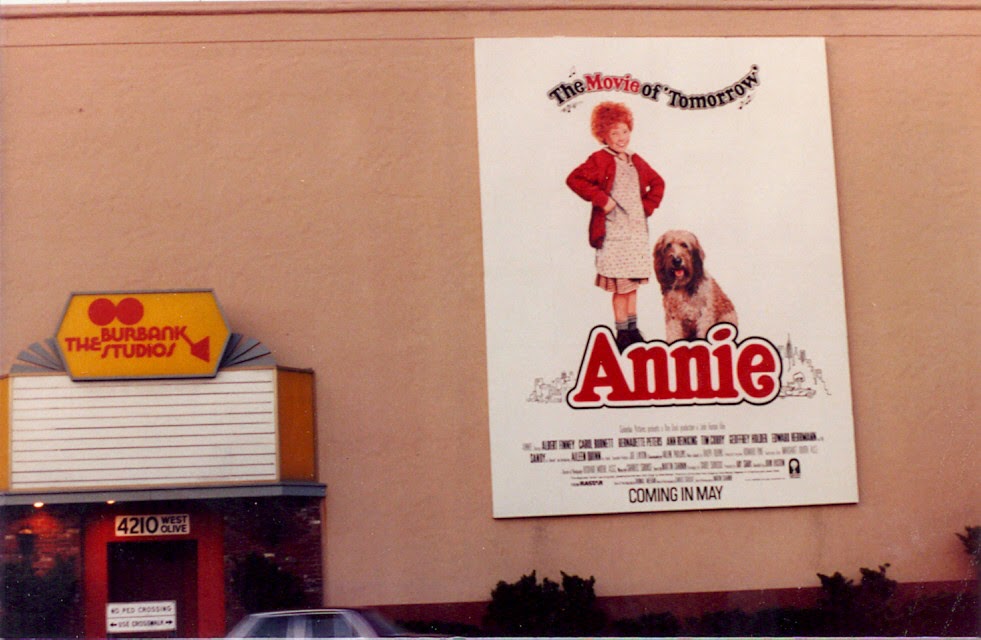 |
| "Mrs. Mulwray, I think you're hiding something." |
Whether for the prestige, visual opulence, short-hand history, or easy-access sentimentality, period films and costume dramas have always been a Hollywood staple and a vital part of movie storytelling. But in the 1970s, the need for some kind of collective breather from the relentless tensions of the “Now” (i.e., Vietnam War, Watergate, impeachment, oil crisis, inflation) produced a market-surge interest in movies set in the “Then.” Particularly the then of the 1920s and 1930s.
Some of these films were escapist homages to retro genres (At Long Last Love -1975). Some were style-fetish showcases devoted to the detailed reconstruction of the fashions, furnishings, and décor of the era (The Great Gatsby -1974). And some were trenchant exercises in ‘70s disillusionment whose nihilist themes were tempered by the distancing device of taking place in America's recent past (The Day of the Locust -1975). Roman Polanski’s Chinatown managed to be all three.
 |
| Jack Nicholson as Jake Gittes |
 |
| Faye Dunaway as Evelyn Cross Mulwray |
 |
| John Huston as Noah Cross |
The collaborative effort of the members of the “New Hollywood” Boys Club: producer Robert Evans (The Godfather, Marathon Man), screenwriter Robert Towne (Shampoo, The Last Detail), and director Roman Polanski (Rosemary’s Baby, Macbeth), Chinatown had a bumpy, three-year journey to the screen (covered in deliciously intricate detail in Sam Wesson’s book The Big Goodbye: Chinatown and the Last years of Hollywood). But when Chinatown premiered in theaters in the summer of 1974, the many arguments, rewrites, firings, walkouts, and endless weeks of tinkering proved not only to be more than worth the effort, but stood as evidence of the degree of care and artistry that went into fashioning a film that many today regard as a modern masterpiece of American cinema.
 |
| Love the composition of this shot. Even the body language of the characters is perfect |
Hardly considered the sure-fire success its current reputation would suggest, Chinatown struggled through disastrous previews and a difficulty generating pre-release interest in a 1974 movie marketplace dominated by the twin publicity blitzkriegs of Lucille Ball's ill-conceived Mame and Robert Redford's The Great Gatsby. Three-time Oscar nominee Jack Nicholson (his most recent being a Best Actor nod for 1973's The Last Detail) was hot at the time, but there existed considerable doubt among many as to how he would come across in this, his first stab at a leading man glamour role.
Meanwhile, Faye Dunaway's post-Bonnie and Clyde screen output had proved erratic at best, with her The Thomas Crown Affair (1968) golden girl patina coming perilously close to tarnishing after a string of arty flops and effective but unfruitful supporting roles. Then there was Roman Polanski...with his days as New Hollywood's European wunderkind a matter of history and coming fresh off two back-to-back boxoffice bombs (Macbeth -1971 and What? -1972), his name carried about it an aura of fall-from-grace tragedy (the Manson murders) in a town ruled by superstition.
 |
| Darrell Zwerling as Hollis Mulwray |
Further contributing to the uncertainty surrounding the film's reception was the fact that a quick recounting of Chinatown's plot-- "A private eye in 1937 Los Angeles investigates a mystery involving a real estate swindle and the city's water rights!" --didn't exactly set the pulse racing.
But what Chinatown had going for it was that it was an original. Not an adaptation of a previously-produced novel, film, or theatrical production. As '70s movies became more formulaically bloated (The Way We Were -1973) and market-driven slick (The Sting - 1973), Chinatown's creative integrity vs its dubious box-office prospects felt like a throwback to Hollywood's very recent past. Back to the start of the decade when difficult-to-categorize films like Diary of a Mad Housewife (1970) and Five Easy Pieces (1970) were being made because they were stories the filmmakers wanted to tell, not because they were sure-fire blockbuster material.
The first time I saw Chinatown, it had me in its hip pocket the minute those stylish opening titles appeared to the accompaniment of Jerry Goldsmith's mysteriously forlorn theme music. And though the film had an alluringly old-fashioned sound and succeeded in creating a vision of a past that felt lived-in, not decorative, Chinatown somehow managed to sidestep things that might have made it feel imitative or as paying affectionate homage to another movie…Chinatown looked and felt like the genuine article.
It didn't seem quite possible that Polanski and Co. had managed to make a film that worked magnificently as a mystery (the particulars of the twisty plot--murder, political swindling, family secrets ---are not exactly easy-to-follow on first viewing); achieved a kind of visual poetry (the movie looks swelteringly hot! How did they do that?), and was propelled by the emotional connection of compelling characters whose fates you came to care about (the performances are uniformly first-rate...right across the board).
Chinatown, in both style and execution, is a jet-black neo-noir that realizes--with a persuasive canniness I still can't quite put my finger on--both Robert Towne's goal of writing a story in the tradition of Raymond Chandler Dashiell Hammett, and Roman Polanski's desire to create: “A film about the ‘30s seen through the camera eye of the ‘70s.”
Given a contemporary sheen thanks to its widescreen Panavision color photography that "feels" like B&W, Chinatown evokes the classic detective movies of the past via its keen eye for period detail and avoidance of so many of the nostalgia-craze movie gimmicks of the time: no diffused lighting, no voiceover narration, no self-conscious “period” jargon, and no knowing winks to the audience. And here's a bonus...the actors actually look comfortable and convincing in their period clothes! (For the alternative, aka, kids playing dress-up, see Baz Luhrmann's The Great Gatsby - 2013 or Mank - 2020).
The result is a movie that's as satisfying as a genre entertainment as it is a dark and existentially layered contemplation on corruption, the destruction of innocence, and, as per Towne, "The futility of good intentions."
THE STUFF OF FANTASY
One of the main reasons Chinatown made such an impression on me is that it was the very first noirish private eye movie I ever saw.
In 1971 LIFE magazine devoted its February cover to America’s burgeoning nostalgia craze, and by 1974, everything from fashion to music reflected the nation’s fascination with life enjoyed in the rear-view. The summer of 1974 saw San Francisco movie theaters so overflowing with retro fare, it took considerable effort to find a film set in the present day: Chinatown, The Great Gatsby, The Lords of Flatbush, That’s Entertainment!, Mame, The Three Musketeers, Daisy Miller, Thomasine and Bushrod, Blazing Saddles, Jeremiah Johnson, Huckleberry Finn (of all things), and Our Time (a little-seen coming-of-age movie set in the ‘50s that opened at the Alhambra during the summer I worked there as an usher).
When Chinatown came out I was a 16-year-old movie buff with a passion for contemporary films almost to the exclusion of all else. Back then, my appreciation for classic movies was largely academic and aesthetic (i.e., I enjoyed reading about them and decorated the walls of my bedroom with posters of Marilyn Monroe, Glark Gable, and WC Fields), not practical. Which meant I hadn’t yet seen The Big Sleep, The Maltese Falcon, or any of those classics on The Late Show about hard-boiled detectives and dangerous women. At sixteen I was much too in thrall of the then taboo-shattering adult themes and newfound unrestricted nudity, sex, & violence of ‘70s films to ever find the Production Code coyness of old movies to be of much interest. That is, except for musicals. Ken Russell’s The Boy Friend (1971) ignited my love for old MGM musicals and the films of Busby Berekely, but that’s pretty much where my interest in “Golden Age" Hollywood films began and ended.
The latter point, my love of musicals, goes to plain why, when That’s Entertainment! and Chinatown both opened on the same day in San Francisco (Wednesday, June 26th), I opted for That’s Entertainment!. An option I exercised for two more weekends before getting around to seeing Chinatown.
 |
| Roman Polanski as Man with Knife |
WHAT I LOVE ABOUT THIS FILM
Maybe it’s the Blu-ray talking, but I’m obsessed with what a fabulous-looking movie Chinatown is. The Oscar-nominated team of cinematographer John A. Alonzo, production designer Richard Sylbert, and art director W. Stewart Campbell give Chinatown an atmospheric sheen that is often breathtaking in its evocation of sun-baked Los Angles in the late ‘30s.
But despite the obvious care and expense lavished on every frame, Chinatown's distinction is that it is a period film that has no interest in romanticizing the past. With traditionally swept-under-the-nostalgia-carpet realities like racism and classist privilege flowing like an undercurrent in a narrative propelled by graft, collusion, murder, and incest; Chinatown’s surface sheen creates a dichotomy that challenges the dreamy ideals one associates with old movies. Cynicism has always been a part of the detective movie genre, but no matter how nihilist the theme, by fade-out, the requisite virtues of honor, heroism, and the triumph of good had to be reinstalled. Chinatown, however, ends with a punch to the gut and the ground knocked out from under us.
 |
| Me in 1974: "Wow, even in so-called simpler times, rich people were greedy and corrupt!" Me in 2021: "Wow, this movie is almost 50 years old and the rich are still as corrupt and greedy as ever!" |
PERFORMANCES
Robert Towne wrote the character of J. J. Gittes with pal Jack Nicholson in mind, so the star-making role of the principled private eye with a taste for Florsheim shoes and words like “métier” fits the actor as perfectly as one of Jake’s tailored suits. This is my favorite of all Nicholson’s performances and arguably his last real immersion in character before entering the “Wink-wink, it’s me! Jack Nicholson!” phase of his career. The entire film is from his perspective...Chinatown is Jake’s journey. But its mystery, tragedy, and heart (and my favorite character) is Evelyn Mulwray.
 |
| Jane Fonda in Julia (1977) - Even Robert Towne had Fonda in mind when he wrote Chinatown |
As Chinatown’s woman of mystery (she who must not be known until Act III), Evelyn Mulwrays’s impact has to be visual. A guarded woman who’s erected an immaculate façade to conceal just how badly she’s damaged, Evelyn intrigues because she is not at all what she seems. So defining a character trait is Evelyn’s appearance that when the film starts to peel away the layers of Evelyn’s very literal “mask” of makeup as her vulnerability is exposed, those moments achieve a poignancy that makes the film's tragic denouement all the more devastating. Faye Dunaway captures all this magnificently, but is seldom given credit.
THE STUFF OF DREAMS
There are a great many '70s films that I love in spite of (or because of) their flaws. But only a few I'd call perfect. Robert Altman's 3 Women (1977) gets my vote for being a wholly perfect film, so does Ken Russell's Women in Love (actually a 1969 film, but I'm cutting myself some slack because it wasn't released in SF until 1970), and most definitely Chinatown qualifies.
And by perfect I don't mean an absence of technical goofs or anachronism errors... it's more the feeling of everything fitting so well together that you can't imagine anything being improved upon. The feeling that a story has been told in precisely the manner the filmmakers wanted to tell it. In the case of Chinatown, everything falls into place so ideally, from the cast to the music to the dialogue to the score...watching it becomes an immersive, deeply satisfying experience that engages on so many levels. I never tire of revisiting it, and the film seems boundless in offering new things to discover even after all this time. But best of all, it still manages to move me.
I'm no longer as totally destroyed by it as I was when I was 16, but at age 63, this masterwork of cinema persists in giving me waterworks every single time.
Thankfully, films are frozen in time. People, alas, are not. In 1974, audiences drew subconscious parallels between the dogged tragedies of Roman Polanski's personal life and the cursed fate of J.J. Gittes. Today, I'm afraid the parallels linking Polanski and Noah Cross fairly hit one over the head.
BONUS MATERIAL
Actor Paul Jenkins, who plays Policeman #1 in Chinatown (1974), made his film debut as a policeman in Polanski's Rosemary's Baby (1968).
Chinatown was planned as the first film in a trilogy. A plan which ground to a halt after the weak boxoffice performance of the second entry, The Two Jakes (1990). Set in 1948, the Jack Nicholson-directed sequel sorely misses Polanski's gift for cinematic storytelling and gets my vote for film most likely to convince you that Chinatown didn't need a sequel in the first place. Still, I did get a kick out of seeing these actors from the original return.
 |
| Poster art by Jim Pearsall |
The water motif is worked in with the wave crashing against Nicholson's sleeve, it being one of several elements of the poster that refuse to stay within the boundaries of the frame. From the lettering to the heat-glare effect of the coloring, everything about this poster is just perfect.
Copyright © Ken Anderson 2009 - 2021














































.JPG)










.jpg)
